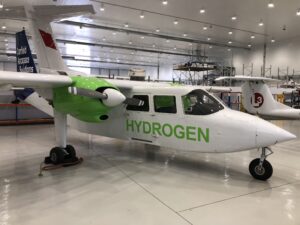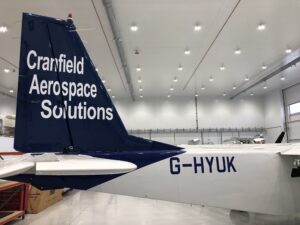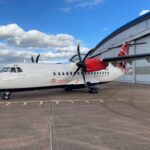Cranfield Aerospace Solutions chief executive Paul Hutton speaks to FINN about his ambition for the company to be a global leader in low- and zero-carbon sub-regional and regional aircraft
British aviation pioneer Cranfield Aerospace Solutions (CAeS) is making steady progress towards its goal of putting a Britten Norman Islander – converted to run on hydrogen-electric power – into the skies by 2024.
This year has seen the opening of a new state-of-the-art facility at its Cranfield base and the arrival of new investors as it seeks to raise £30m to fund Project Fresson.
The first phase of its plan to decarbonise aviation is to make the hydrogen fuel-cell powered nine-seater Islander a commercially viable aircraft, with the ultimate goal of becoming an airframer of low and zero carbon sub-regional and regional aircraft.
 Hydrogen has three-times the energy density of conventional aviation fuel and produces zero CO2 emissions. That compares with current battery technology that has around one-tenth the energy density of aviation fuel.
Hydrogen has three-times the energy density of conventional aviation fuel and produces zero CO2 emissions. That compares with current battery technology that has around one-tenth the energy density of aviation fuel.
CAeS has been in talks with Scottish carrier Loganair and SkyBus in south-west England over future use cases for the sub-regional aircraft using hydrogen fuel cell propulsion.
Prioritising commercial viability, coupled with technical expertise and a focus on answering the needs of today’s aviation market, sets CAeS apart in a crowded field of low or no-emissions aircraft developers.
“For the Islander, even though it can fly for three or four hours, 85% of its operations today are 60 minutes of flying or less,” CAeS chief executive Paul Hutton said, during an interview with FINN at the company’s HQ.
“We made sure we chose an aeroplane that was commercially viable with a relatively short range, because we’re aircraft people, not technology evangelists.
“We knew it would be hard, so we’ve always, from day one, looked to give it 60 minutes of flight plus 45 minutes reserve.”
Viable design
Hutton said that CAeS’ focus on producing a modified demonstrator airframe that closely resembles the finished product is key to making the project a success.
 “If you pick a couple of our competitors, in one case, they’ve just put the electric motor in the nacelle and put the hydrogen fuel cell system in the fuselage, and they’re producing half the power from a battery,” he said.
“If you pick a couple of our competitors, in one case, they’ve just put the electric motor in the nacelle and put the hydrogen fuel cell system in the fuselage, and they’re producing half the power from a battery,” he said.
“If you want to produce a product, the demonstrator has to use the aeroplane that you’re going to deliver, and deal with the specific challenges that aircraft will see in flight.”
In the skies by 2024
The current timeline will see the converted Islander take to the skies for the first time by the end of 2024.
“Part of the reason that it has taken a while is that we’re taking a very different approach to other hydrogen demonstrators,” Hutton explained.
“When our aircraft flies, on one wing we have the conventional technology, to help with the safety case, and new technology is on the other wing.
“On the new technology wing, it will have 110% of the power of the engine it replaces – that extra 10% is because of the extra drag of the system that we put onboard, so we will need a little extra power.
“We’ve packaged not only the electric motor, but the whole fuel cell system, into the volume of the nacelle, and produced 110% power.”
One of the major challenges with this type of technology is thermal management. So CAeS has partnered with Reaction Engines to address this, within the confined space of the nacelle and while seeking to minimise drag.
Reaction Engines’ heat exchanger technology has been demonstrated as a key enabler for a lightweight and low drag solution, and can handle over 600kW of rejected heat.
Hybrid-electric and battery-powered solutions
Hutton is sceptical about the viability of hybrid-electric and battery-powered solutions, and the eVTOL industry that relies on this nascent technology.
“When you’ve got immature technologies, the last thing you want to do with them is take off vertically, it just makes your life much harder, it might look sexy in the photographs, but it just won’t work,” he said. “An aeroplane that uses wings on a runway has a much better chance of getting in the air, and staying in the air.”
CAeS, which began work to convert an Islander in 2019, has opted for gaseous hydrogen instead of using the element in its liquid form.
Gaseous hydrogen
Gaseous hydrogen comes with a lower range potential but is easier and cheaper to make available in the numerous small airfields it is hoped the Islander will be flying to by 2026.
“The main reason we chose gaseous hydrogen instead of liquid was the technology is immature,” said Hutton.
“Importantly, in 2026, the ability to guarantee the availability in all those little airports where the Islander could be used of liquid hydrogen fuel at -260 degrees centigrade was unlikely. Whereas gaseous hydrogen in its most inelegant form can come in bottles on the back of a truck – as simple as that. Any small airfield that gets truck deliveries can get its fuel right now.”
Britten-Norman merger
Earlier this year Britten-Norman and CAeS signed a Heads of Terms agreement, signalling their intention to merge.
CAeS is currently undertaking due diligence and a decision on the merger is expected at some point in September.
In the meantime, CAeS is seeking to attract new investors with a £30m fundraising target. The company is currently talking to six or seven investors and Hutton is hopeful that this funding figure will be met.
Initial plans for CAeS’ hydrogen-electric aircraft programme showed work on the nine-seater being scaled up to a 19-seater and then a larger regional aircraft with capacity for up to 100 people.
But Hutton said this was now being delayed as the company explored “adjacent markets” – aircraft of a similar size to the Islander, or smaller, which could more readily integrate the technology. “There’s much more opportunity to exploit what we’ve already developed before we need to make the next step,” he said.
The benefit in waiting before scaling up the technology is that it gives the ground-based hydrogen infrastructure time to develop, Hutton explained.
Modernised hangar
In July, CAeS unveiled its modernised hangar facility, which will be used to modify the Islander as well as to develop the procedures and processes required for the maintenance of future hydrogen-powered aircraft (while still maintaining its conventional MRO function which specialises in wide-bodied and light aircraft such as Diamond DA 40/42 Series and Piper Singles and Twin Piston Engine Series).
Hutton said CAeS would “very quickly become the world’s experts in hydrogen fuel cell propelled aeroplanes because we are likely to be the first or one of a very small number doing it”.
“Whilst the big companies are working on the big aeroplanes that will be there in 2035+, the Islanders will be flying for many years before that. We’ll be at the cutting edge of those maintenance processes, and they can be monetised.”
Subscribe to the FINN weekly newsletter
You may also be interested in:
CAeS unveils new facility for zero-emissions aircraft project

